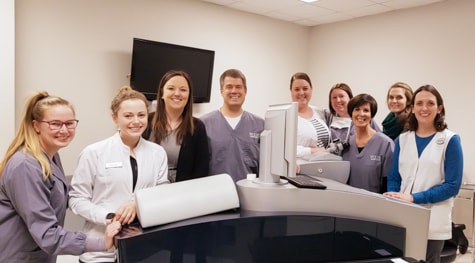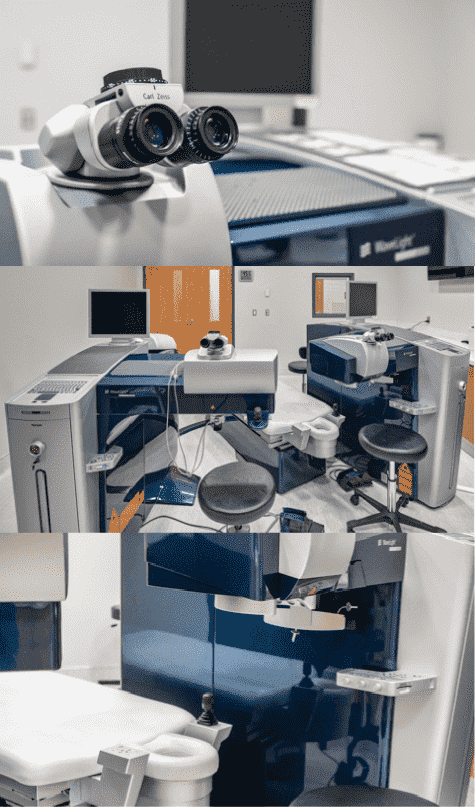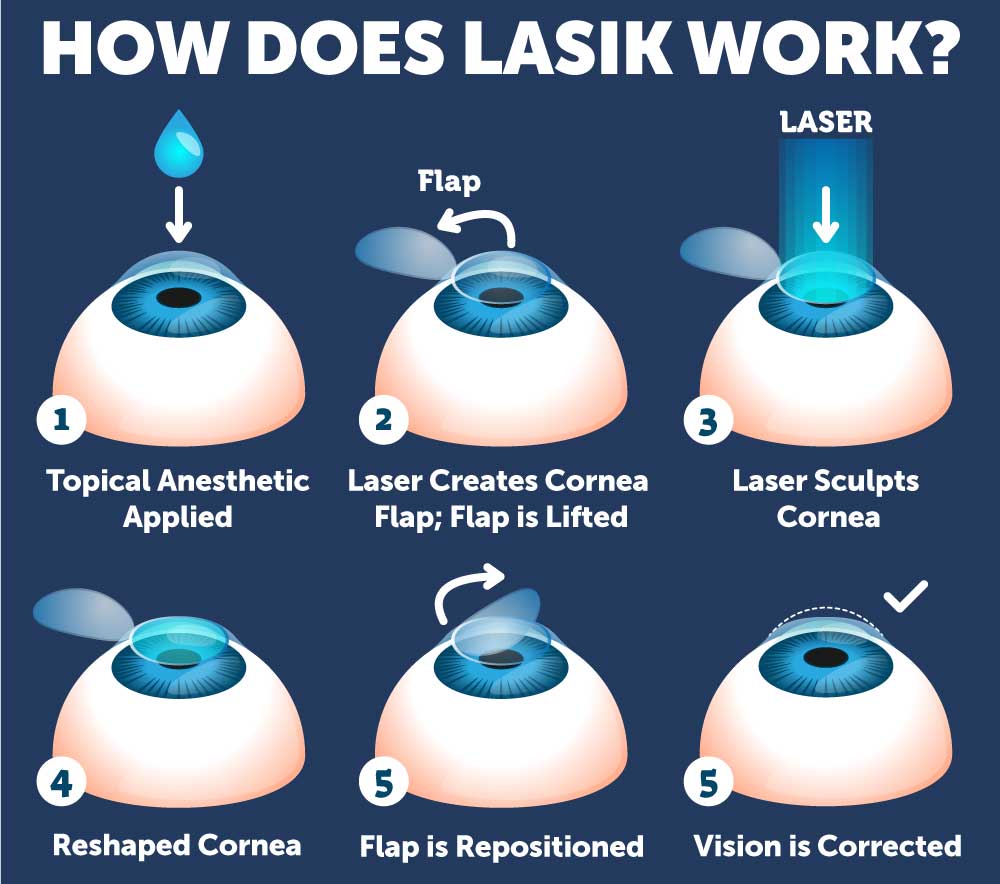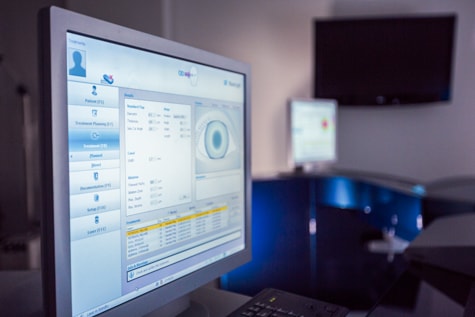LASIK Surgery and Technology
LASIK is a form of refractive surgery, also known as corrective eye surgery. Refractive surgery encompasses a multitude of procedures designed to treat and correct refractive errors including nearsightedness (myopia), farsightedness (hyperopia) and astigmatism. Refractive errors cause patients to need eyeglasses or contact lenses in order to see nearby or in the distance. Correcting refractive errors through surgery helps patients naturally see clearly without eyeglasses or contact lenses.
Laser in situ keratomileusis, or LASIK, is the most commonly performed refractive surgery procedure today and is the primary procedure of choice at Wolfe Eye Clinic. LASIK is considered a safe procedure for the right candidates that has many long-term advantages over other refractive surgeries, including a relative lack of pain and quick healing. Additionally, good vision is usually achieved almost immediately or in a very short period.
Simply put, LASIK reshapes the cornea’s curvature. Reshaping the cornea’s curvature allows light to accurately enter the eye and focus on the retina, thereby helping patients see clearly without eyeglasses or contacts. LASIK works in two steps, creating a corneal flap and then reshaping the underlying cornea’s curvature. Since 2002, Wolfe Eye Clinic surgeons have used all-laser, 100% bladeless technology to perform both steps of LASIK. Some other providers elsewhere still use a hand applied mechanical instrument with a motorized metal blade rather than modern laser-precision technology.
All-Laser LASIK Technology
As you research more about LASIK laser eye surgery, you will come across several other types of vision correction surgeries and technologies available.  This is an important consideration when determining what is best for you. Not only does Wolfe Eye Clinic use the most modern all-laser technology available but our LASIK surgeons listen to you about your vision goals and use the data gathered at your free LASIK consultation to recommend the best procedure for you and your eyes. Unlike some other providers, Wolfe Eye Clinic surgeons will not offer a “menu” of treatment options and technologies at various price ranges. We provide only the best available technology to all of our patients and never offer lesser technology for a lower price. We will not settle for anything less than the best for you!
This is an important consideration when determining what is best for you. Not only does Wolfe Eye Clinic use the most modern all-laser technology available but our LASIK surgeons listen to you about your vision goals and use the data gathered at your free LASIK consultation to recommend the best procedure for you and your eyes. Unlike some other providers, Wolfe Eye Clinic surgeons will not offer a “menu” of treatment options and technologies at various price ranges. We provide only the best available technology to all of our patients and never offer lesser technology for a lower price. We will not settle for anything less than the best for you!
A Modern, Industry-Leading Approach to LASIK Laser Eye Surgery
Wolfe Eye Clinic performs all-laser LASIK, the modern approach to LASIK surgery. Unlike other providers, we own all components of the WaveLight® Refractive Suite including the laser-flap creator (WaveLight® FS200), vision correcting laser (WaveLight® EX500) and swivel bed. The Alcon WaveLight® Refractive Suite offers the fastest total refractive procedure in the United States and is housed in our climate-controlled operating rooms.
 All-laser refers to using precise laser technology during both steps of LASIK to correct vision. Historically, a handheld motorized surgical blade was used. Some providers still use the blade technique to this day during step one of LASIK while creating corneal flaps, opting to forego laser precision and control, and while introducing more surgical risk. Whereas, in 2002, Wolfe Eye Clinic introduced Iowa to the modern approach of all-laser LASIK.
All-laser refers to using precise laser technology during both steps of LASIK to correct vision. Historically, a handheld motorized surgical blade was used. Some providers still use the blade technique to this day during step one of LASIK while creating corneal flaps, opting to forego laser precision and control, and while introducing more surgical risk. Whereas, in 2002, Wolfe Eye Clinic introduced Iowa to the modern approach of all-laser LASIK.
Our WaveLight® bladeless, all-laser technology offers our surgeons significant corneal flap precision to remove most of the surgical risk previously associated with making corneal flaps using a mechanical microkeratome blade. Additionally, this technology allows us to provide customized LASIK. Specifically, we collect your custom eye measurements during your LASIK evaluation and program your data into our WaveLight® technology. Using this data, our surgeons are able to provide you with the flap size and shape needed to perform treatments customized to your eyes.
For an even more customized treatment, Wolfe Eye Clinic offers Contoura® Vision, also known as topography-guided LASIK. Contoura Vision is the latest FDA approved evolution in advanced custom LASIK technology. It combines the WaveLight® EX500 Excimer Laser with the Wavelight Topolyzer Vario to improve upon traditional LASIK. Contoura Vision uses the unique topography of your cornea’s surface to adjust the treatment and smooth out any irregularities on the cornea. Not all patients qualify for Contoura Vision treatment though. Your surgeon will discuss with you whether you may be a good candidate for Contoura Vision.
How does LASIK work?
Patients are not put under anesthesia for LASIK procedures. Rather, you are awake during LASIK, but given a relaxing medication to help relax and  comfort you prior to surgery. Patients then lay on a swivel bed as part of Wolfe Eye Clinic’s WaveLight® Refractive Suite. Heavy numbing drops are placed on the operative eyes to reduce discomfort and the need to blink. A gentle device is used to assist with keeping your eyes open, which also assists in preventing blinking during laser eye surgery. LASIK eye surgery is not considered painful by most patients. Patients describe LASIK as feeling like a pressure that is being applied to their eye.
comfort you prior to surgery. Patients then lay on a swivel bed as part of Wolfe Eye Clinic’s WaveLight® Refractive Suite. Heavy numbing drops are placed on the operative eyes to reduce discomfort and the need to blink. A gentle device is used to assist with keeping your eyes open, which also assists in preventing blinking during laser eye surgery. LASIK eye surgery is not considered painful by most patients. Patients describe LASIK as feeling like a pressure that is being applied to their eye.
LASIK works in two steps, one eye at a time. Your LASIK surgeon talks you through each step as it is happening. You have a team of experts next to you throughout the procedure. If you would like, they can even hold your hand for comfort.
 The WaveLight® FS200 Femtosecond Laser, using your custom eye measurements, creates a precise thin flap from the outer corneal tissue. Utilizing PerfectPulse Technology®, the FS200 offers complete control over corneal flap size, depth, location and hinge orientation, removing most of the surgical risk previously associated with making corneal flaps.
The WaveLight® FS200 Femtosecond Laser, using your custom eye measurements, creates a precise thin flap from the outer corneal tissue. Utilizing PerfectPulse Technology®, the FS200 offers complete control over corneal flap size, depth, location and hinge orientation, removing most of the surgical risk previously associated with making corneal flaps.- Your surgeon seamlessly and gently swivels your bed over to our WaveLight® EX500 Excimer Laser. The flap is then carefully lifted, exposing the base of your cornea for laser treatment. Our WaveLight® EX500 Excimer Laser applies pulses of laser light to reshape the curvature of the cornea. Last, the corneal flap is carefully placed back over the cornea to begin the healing process.
Watch our video about what to expect during the LASIK procedure from our experts at Wolfe Eye Clinic!
You do not need to worry about blinking or moving your eyes as the WaveLight® EX500 Excimer Laser uses multi-spatial eye-tracking technology that tracks movement ten times faster than that of your natural eye movements. We were the first in Iowa to obtain the Wave Eye-Q 400 Hz Excimer Laser in 2007, and most recently the Allegretto Wavelight® EX500. Benefits to our advanced technology include:
-
Widest treatment approval range ever granted to an excimer laser
-
Enhancement (i.e., touch up) rate of under five percent, better than most other providers
-
Studies show this may preserve or improve quality of vision with respect to glare and night driving glare
-
Helps reduce the potential for flap complications
What to Expect After LASIK
Following surgery, your surgeon provides clear eye shields to wear and you are instructed to rest. How long after laser eye surgery you can see improvement varies per patient. Some patients can see crisp and clear following a short rest after the procedure. Other patients require more time for vision to stabilize. You are typically able to return to work the following day and your vision may be even better just one day after surgery. Patients are able to watch TV after LASIK and perform normal activities within a day or two. You are instructed to avoid swimming and hot tubs for a couple of weeks and it is also important that you do not rub or bump your eyes during this time.
Laser Eye Surgery Recovery and Outcomes
LASIK laser eye surgery is generally considered safe for the right candidate. As with any surgery, there are risks involved including dry eyes, vision fluctuations, glare, halos, corneal flap complications, or vision loss. It is important to note that the chance of having a serious vision-threatening complication is less than one percent.
Your surgeon will discuss possible complications, risks and what vision results you can personally expect. At Wolfe Eye Clinic more than ninety-five percent of patients do not need any further corrections as our enhancement (i.e., touch up) rate is less than five percent. Most patients wish they would have done LASIK sooner and recommend their friends and family to come see the LASIK surgeons at Wolfe Eye Clinic.
Frequently Asked Questions about LASIK Surgery
Is LASIK done under anesthesia?
LASIK is not performed under anesthesia. Rather, we provide a relaxing medication and administer strong numbing drops to the eyes to reduce discomfort. The procedure is performed in a climate-controlled laser facility.
How does LASIK feel?
Patients often describe the feeling during LASIK surgery as a pressure and awkward feeling. These sensations are generally felt most during step one, while the flap is being created by the laser. Patients typically don’t feel much during step two when the cornea is being reshaped. The procedure is not considered painful and patients are often relieved by how relatively quick the procedure is. Following surgery, as the eye numbing drops begin to wear off and your eyes begin to heal, it is normal to feel discomfort and irritation for a few hours. For this reason, you are instructed to nap or rest your eyes during this relatively short time to relieve irritation.
How safe is LASIK eye surgery?
LASIK eye surgery is the most commonly performed refractive surgery and is considered safe for the right candidate. As with any surgery, there are risks including dry eyes, vision fluctuations, glare, halos, corneal flap complications, or vision loss. Fortunately, the chance of having a serious vision-threatening complication is less than one percent and the use of a laser like Wolfe Eye Clinic uses significantly reduces the risks that were previously associated with making corneal flaps using a mechanical microkeratome blade.
How long do the results of LASIK surgery last?
During LASIK, the cornea is being permanently reshaped. The results of LASIK are generally lifelong, and most patients wish they would have had the procedure done earlier. At Wolfe Eye Clinic, over ninety-five percent of patients do not need any further corrections (i.e., enhancement, touch-up). There is a common misconception that the vision correcting effects of LASIK may “run out” with time but this is not the case. However, if your eyes change due to presbyopia, cataracts or other medical conditions, you may once again require some glasses correction to see your best.
What happens if you blink during LASIK?
In preparation for the appointment, you are given strong numbing eye drops to reduce your need to blink. Additionally, a gentle device is used to keep your eyes open and our advance eye-tracking technology is able to track eye movement ten times faster than your natural eye movement. These measures nearly eliminate the risk of blinking and your surgeon will communicate with you if there are concerns.
How long after LASIK can you see?
You are able to see immediately after the procedure. The majority of patients are able to see the benefits of LASIK shortly after the procedure. However, it is normal for vision to fluctuate for a few weeks or longer.
How long does it take to recover from laser eye surgery?
Every patient is different. Most patients are back to work the following day and their normal activities within a few days. It is important to take extra precaution for weeks after surgery to ensure you do not bump, rub or get debris in your eyes.
Can I watch TV after LASIK?
Patients should rest immediately following the procedure. After resting, you may watch TV or use electronic devices, but should give your eyes frequent breaks.
Contact the LASIK Experts at Wolfe Eye Clinic
To find out if you are a candidate for LASIK, please call one of our LASIK Coordinators at (833) 532-8809 or request an appointment online here to schedule a free LASIK consultation near you. Wolfe Eye Clinic has experienced LASIK surgeons across the state. We offer free LASIK consultations at our Ames, Ankeny, Cedar Falls, Cedar Rapids (Hiawatha), Des Moines, Fort Dodge, Iowa City, Marshalltown, Ottumwa, Pleasant Hill and Waterloo clinics.